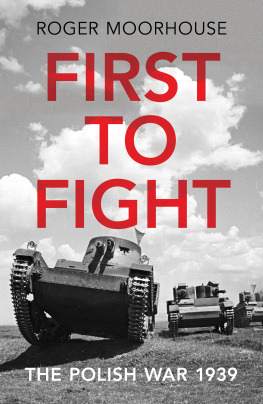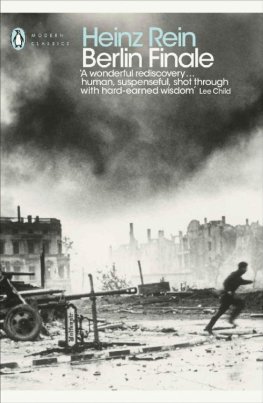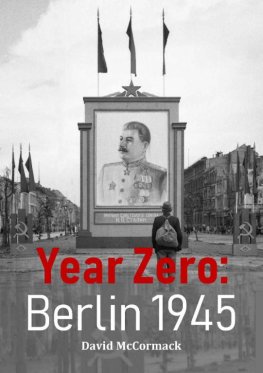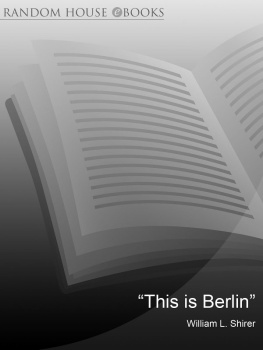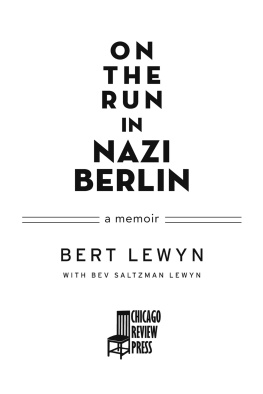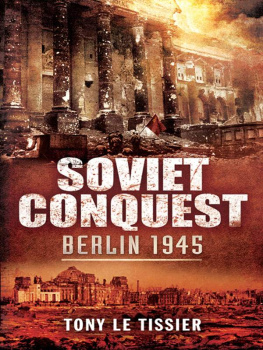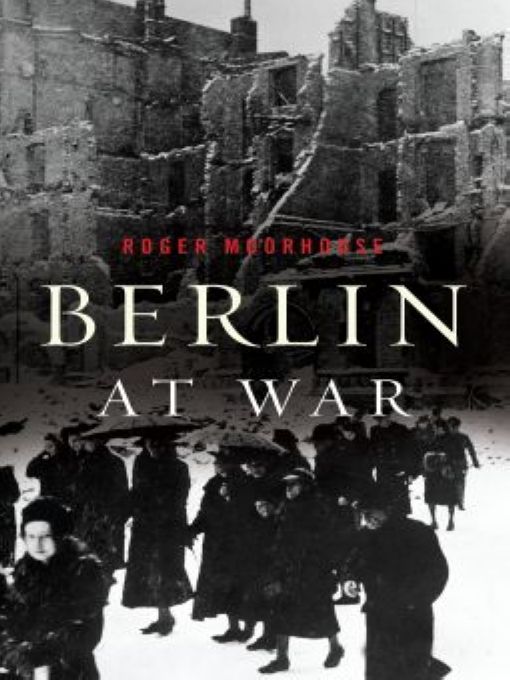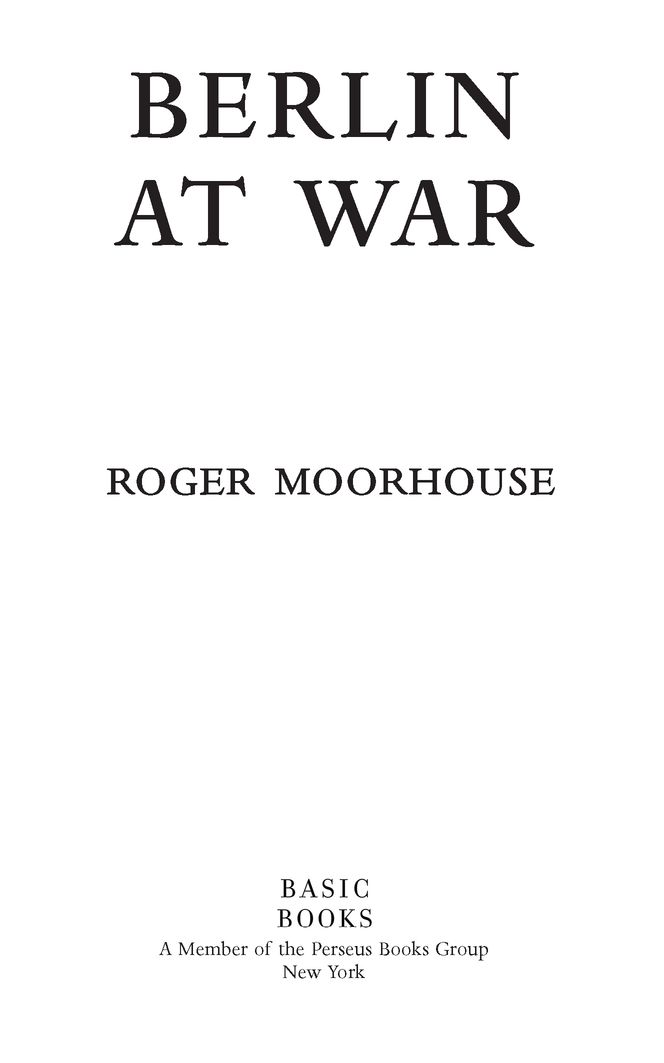Table of Contents
BY THE SAME AUTHOR
Microcosm:
Portrait of a Central European City
(with Norman Davies)
Killing Hitler:
The Third Reich and the
Plots against the Fhrer
For
Amelia
in the hope that she
will never have to experience
times such as these
and for her great-grandparents
Paul & Hildegard Schmidt
who did
Acknowledgements
Any work of research carries many debts along with it and this book is certainly no exception. Many people have helped along the way, amongst them Philipp Rauh and Saskia Smellie, who helped with ancillary research in Berlin; Kinga Boruc at Carta Blanca (Warsaw), who designed the maps; and Phil Berks at Digital Services (Tring), who rescued my manuscript from a potentially catastrophic hard-drive crash.
Thanks are also due to all those friends and colleagues who answered specific queries and kindly shared their knowledge, amongst them Norman Groom, Cord Pagenstecher, Michael Foedrowitz, Gregers Forssling, Giles MacDonogh, James Holland, Nick Stargardt and Nigel Jones.
Special mention must of course be reserved for all those Berliners of the wartime vintage with whom I spent so many enjoyable and enlightening hours conducting interviews. Without their reminiscences, their manuscripts and their diaries, this book would simply not have been possible, and I am only sorry that the march of time has robbed some of them of the satisfaction of seeing the finished product.
In setting up that programme of interviews, I incurred a number of significant debts, not least to Wieland Giebel of Berlin Story and to Thessi Aselmeier and all those at the excellent Zeitzeugenbrse.
I would also like to extend my thanks to some of the institutions in which the research and writing of this book was carried out, amongst them the Deutsche Tagebucharchiv in Emmendingen, the Landesarchiv Berlin, the National Archives in Kew, the British Library and the excellent German Historical Institute in London. In addition, the guides of Berliner Unterwelten deserve credit for making my visits to some of the more esoteric sights of the German capital so enlightening.
Lastly, mention must be made of all those others who made this project possible: my agents, Peter Robinson in London and Jill Grinberg in New York, and my editors Lara Heimert and Brandon Proia in New York and Will Sulkin and the incomparable Jrg Hensgen in London. I am indebted to all of you for your insight, your perseverance and your unflagging enthusiasm for this project. Thank you.
Convention dictates that I dedicate this book to my daughter Amelia, but I would also like to acknowledge two other familial debts. The first is to my wifes grandparents, Paul and Hildegard Schmidt, who experienced life in Nazi Germany - albeit not in Berlin - and whose reminiscences spurred my interest in the subject. The second is to my wife Melissa, without whose love, support, patience - and occasional impatience - this book would scarcely have seen the light of day.
Roger Moorhouse
May 2010
Introduction
For all its breezy modernity, Berlin is a city that positively reeks of history. If one were looking for a single location - a focal point - for the bloody trials and tribulations of the twentieth century, then one would have to look no further. From the bullet-scarred buildings to the lingering shadows of totalitarian regimes, Berlin experienced world events not as something remote or imperceptible, but rather as immediate, tangible and very real. Last year the city celebrated the twentieth anniversary of the fall of its hated Wall, the moment in which it became the crucible of the death spasms of communism. A generation earlier it had been the plaything of the squabbling superpowers, serving as the backdrop to earnest speechifying and sinister spy swaps. And a generation further back, the then capital of the Third Reich had been the very epicentre of Nazi power - the canvas upon which Speers architectural dreams and Hitlers racial vision would be made real.
Berlin was one of the very few European capitals to experience the horror of the Second World War at first hand. Not only was the city subjected to the full wrath of the Soviet ground offensive and siege in 1945, but it also found itself in the very front rank of the air war. Its wartime military history, therefore, is a catalogue of superlatives. As the most important Allied target, Berlin attracted more air raids, more aircraft and more bombs than any other German city. It was the most aggressively defended target, employing the largest number of personnel in the most elaborate network of defences and costing the largest number of Allied airmens lives. It also outstripped its rivals in its civilian death toll: with an estimated 200,000 casualties it suffered the largest non-military loss of life of any city of Western and Central Europe.
Yet though Nazi Germany and the Second World War are subjects that continue to occupy and fascinate historians, the story beneath those superlatives - the story of civilian life in Berlin during the war - is one that has remained curiously unwritten.
There are a number of reasons why this apparently obvious subject should have become one of the few remaining lacunae in the historical record of Nazi Germany. Historians have traditionally tended to pay comparatively little attention to the social history of Nazism, preferring the top-down approach of analysing the role of Hitler, the Nazi elite or the military. The result is that few of the volumes in the ever-burgeoning canon of literature on the Third Reich shed any light on civilian life at all.
Other factors serve to reinforce this bias. Most important, perhaps, is the fact that those historians that do venture into the social sphere of the Third Reich often tend to concentrate their attentions on the persecution and destruction of the Jews. This is, of course, right and proper, but it has also led to a profound imbalance in our understanding of German society as a whole. We know little about the challenges posed to the German people by living in a dictatorship, the compromises demanded and the principles that, in some cases, had to be abandoned. We know little about the ways in which consent was engendered, how it was maintained and what happened when it broke down. In short, there are a plethora of books explaining how a minority died under Nazism, but there are very few that explain how the majority lived.
Happily, there are a number of factors that strongly encourage an examination of the social history of wartime Berlin. Historiography has been shifting in this direction in recent years, as historians look beyond the bare facts to discern popular reactions to events. Where once grand strategy and high politics were the dominant themes of history, nowadays much more humble everyday subjects and sources begin to proliferate. One might call this process the democratisation of history, marking as it does the shift away from the great and the good in favour of the view from below. This trend is also illustrated by the many published memoirs and diaries that now seem to be ubiquitous in the bookshops.
The most urgent argument in favour of this approach, however, is that this is the final opportunity we have to allow those that experienced the war directly to tell their stories. Many of the voices that I have used in this book are from published sources, but I also wanted to make use of the personal accounts of ordinary Berliners, which have never been recorded for posterity. To this end, I undertook a programme of interviews in the German capital, in which I crisscrossed the city to meet people for whom Berlin at War forms part of their personal story.




